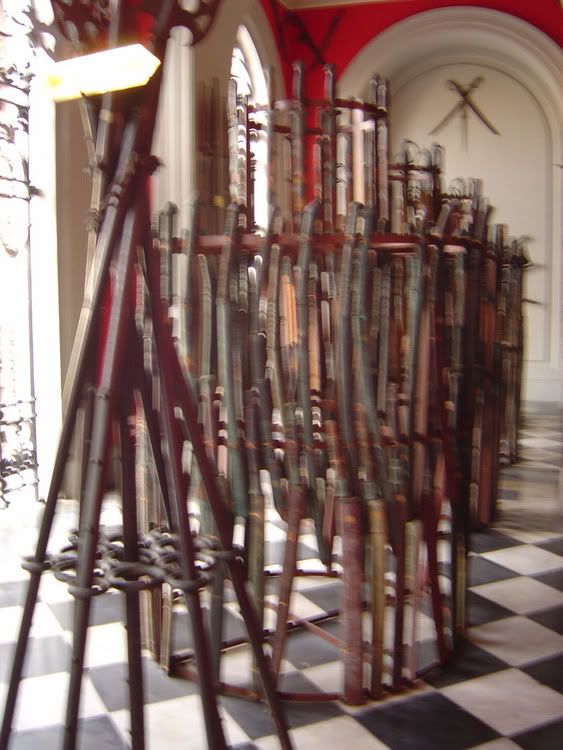
 |
|
|
|
|
#1 |
|
Member
Join Date: Dec 2004
Posts: 987
|
Not very long ago I remember seeing a post (I think on the EEWRS) that noted that there was a difference in how the terms "krabi" and "darb/daab" were used by the Thai -- something about one referring to native swords and the other referring to "foreign" swords. My memory is very sketchy, and I can't find the post with the search function.
Does anyone else remember this, or the basic information from the post? |
|
|

|
|
|
#2 |
|
Member
Join Date: Dec 2004
Location: Virginia
Posts: 520
|
Mark
pretty sure it was in a post from Dan so he would be the best to ask. I remember it saying that dharb/daab would be used for any blade foreign or thai made but that krabi was used only for Thai blades. But as memory is trecherous I am trying to find the post |
|
|

|
|
|
#3 |
|
Member
Join Date: Dec 2004
Location: Oahu, Hawaii
Posts: 166
|
Actually since that post the information has improved. Krabi, as used by the Thais, is a term specifically used for sabres. Every reference, except in that first one I referenced, has applied the term to a sword with a typical sabre hilt and guard most with the long thin hand guard. Many times the blade in that weapon is either an imported blade or a local blade much the same as those Bangkok era blades (thinner and parallel, without the belly swell). An example is shown below
 I have seen this term used in reference to the fighting style Krabi Krabong but the dictionary just defines krabi as sword and krabong as staff. Of course the dictionary also lists Daab only as sword with no qualification. However in the museum labels, book illustrations and discussions the term krabi has, so far, exclusively been used on sabers. In this poor photo you can just make out that the second rack of weapons and the two crossed on the wall in the background are European style sabers - they are labeled in Thai as krabi while the others were labeled as "meed daab" or "daab", "meed" by itself means knive. Don't get confused by the phonetics I use, there are at least three different sets of phonetics that I know of when translating Thai "darb" is just as correct - it is literally "D" - "long soft A vowel(aa)" - "B" but it really sounds more like "darb" when heard by western ears. 
|
|
|

|
|
|
#4 |
|
Member
Join Date: Dec 2004
Posts: 987
|
So, daab refers to what we generically call "dha", meaning dha-lwe (long blade, simple round handle, etc.), and krabi means saber, with the knuckle guard, etc.? Any connotations of foreign versus domestic swords in the terms?
|
|
|

|
|
|
#5 |
|
Member
Join Date: Nov 2004
Location: USA
Posts: 1,725
|
In my research of Thai and Burmese martial arts, the term krabi is invariably used interchangeably with daab or darb to refer to a single sword. I've not seen any differentiation between the two words for different forms of sword, but it does make sense.
As an aside, the term for one sword held in each hand, a common Krabi-Krabong technique, is usually refered to as daab sawng meu. These are always the shorter-bladed, longer-handled swords like those featured in Dan's avatar. |
|
|

|
|
|
#6 |
|
Member
Join Date: Dec 2004
Location: California
Posts: 1,036
|
The design of the fittings on the sheath of the "krabi" shown above is a dead-ringer to the scabbards on a type of Vietnamese saber called a "guom". Note the three metal fittings, with indented contours, the markedly tapering chape with a graceful upswept terminus, and the position of the upper suspension ring (very near the throat). All these features are in common with the scabbard of a typical "guom", which on better examples is mounted in embossed silver. The difference is mainly in material: Vietnamese scabbards are frequently of rosewood, delicately inlaid with MOP.
Many guom have knucklebow guards, like this krabi, albeit of different contour and decorative treatment. I have always attributed the presence of knucklebow hilts in Vietnam to French influence, but after looking at some rather similar "parang nabur" hilts, I'm starting to broaden my outlook. Now that I see this Thai scabbard, I'm wondering even more. I plan on giving a talk on Vietnamese swords in Timonium this coming March, and will have a few examples of guom to show. 'Will look forward to discussing these points with you guys there. |
|
|

|
 |
|
|